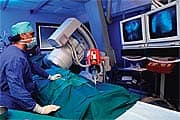Life Extension Magazine®
All too often, the first sign of hidden cardiovascular disease is the last: sudden cardiac death. Many of these deaths are caused by abnormal heart rhythms, or arrhythmias. Arrhythmias—some harmless, some life-threatening—afflict nearly 10 million Americans. While conventional medical treatments focus on invasive implantable devices and medications that carry serious side effects, compelling evidence shows that you can arm yourself against dangerous heart rhythm disorders by optimizing your omega-3 fatty acid intake. Physicians Finally Recommend Fish OilIn the last two years, conventional medical practitioners have increasingly embraced omega-3 fatty acids from fish oil for their heart-health benefits. But just 30 years ago, had you suggested that fish oil could provide extraordinary benefits towards reducing the risk of heart attack, help prevent or suppress abnormal heart rhythms, and even reduce the likelihood of death from heart disease more than any prescription drug known, you would have been laughed out of town. But you would also have had the last laugh.
For years, physicians have dismissed the value of nutritional supplements, including omega-3 fatty acids from fish oil. This unwillingness to utilize fish oil has prevailed despite considerable scientific data documenting the flagrant health damage wreaked by omega-3 deficiency in Americans. Even after a 1999 study showed that heart attack survivors who supplemented with a modest amount of fish oil each day experienced significantly less cardiovascular mortality (30%) and sudden death (45%), many physicians failed to recommend omega-3 fatty acids to their patients.1 Prescription Fish OilPracticing physicians remained reluctant to recommend fish oil until a pharmaceutical company decided that it would commercialize omega-3 fatty acids as a prescription drug. Reliant Pharmaceuticals pushed its version of fish oil omega-3s through human clinical trials, an expensive and laborious process required for FDA approval as a pharmaceutical agent. In November 2004, the FDA approved fish oil as a prescription drug for the treatment of triglyceride levels of >500 mg/dL. (It is standard operating procedure for pharmaceutical companies to obtain drug approval for a single condition that is likely to pass regulatory muster.) Of course, once the product reaches pharmacy shelves, it can be prescribed “off label” for other uses. The initial product name was “Omacor®,” but has recently been changed to Lovaza™ due to confusion from a similar-sounding but unrelated product.
Promptly following FDA approval, marketing efforts exploded. Practicing physicians received weekly visits, phone calls, and emails from eager sales representatives, not to mention invitations to dinners and “educational” conferences. Now, three years and plenty of marketing efforts later, your neighborhood physician is beginning to prescribe fish oil for high triglycerides. The appearance of fish oil as a pharmaceutical agent has paved the path for large clinical trials to study its usefulness for treating a number of conditions. The larger sums that a drug manufacturer can charge for a product (because “drugs” are paid for by the health insurance industry) bring in greater revenues sufficient to fund large clinical studies. Among the emerging applications of omega-3s is the treatment or prevention of heart rhythm disorders, or arrhythmias. Since rhythm disorders are complex, the media has painted a confusing picture of their management with fish oil. Yet if we sift through the hype and media confusion, we will discover that fish oil is emerging as a very powerful treatment for heart rhythm disorders. Although newer studies have focused on the prescription form of omega-3s, fish oil is available to us without a prescription, just as it has been for years. The good news is that fish oil may represent the number one nutritional strategy for protecting against dangerous abnormal heart rhythms.
A Nationwide Deficiency of Omega-3sBefore the late 1980s, the American diet was extremely high in saturated fats, which was linked with an elevated risk of cardiovascular disease.2 In response, many arbiters of healthy eating, including the Surgeon General’s office, the USDA, and eventually even the FDA spoke out against fat intake in the American diet. Thus was born the low-fat era. Not only did Americans receive an introduction to the concept of low-fat foods, but the food manufacturing industry spotted a new opportunity for an entirely new range of products that exploited the low-fat concept: low-fat cookies, low-fat breakfast cereals, low-fat lunch meats, and thousands of others.
Along with the low-fat concept, the same agencies advocated a switch from saturated fats to polyunsaturated fats, based on some evidence suggesting that replacing saturated with polyunsaturated fats reduced blood cholesterol levels, heart attack, and cancer.3 Polyunsaturated fats from corn, safflower, sunflower, and other sources thereby became deeply entrenched in Americans’ nutritional habits. At the same time, a new trend was emerging in the Midwestern farm belt. Traditional American farms, in which livestock roamed and fed on grasses, were replaced with large-scale factory farms that could generate large amounts of low-cost meat. These factory farms kept animals confined to small pens and fed them corn or industrialized food substitute. While grass-fed beef contains a substantial amount of omega-3 fatty acids, factory farm-raised beef does not.4 This trend drove down the cost of meat, but it also depleted the nation’s meat supply of omega-3 fatty acids. Now, most supermarket meat is rich in omega-6 fatty acids, with the resultant greater fat composition visible to the unaided eye as “marbling.”5 Thus, a confluence of events led to creating an excess of omega-6 fatty acids and a depletion of omega-3s in the American diet. Compared to the diet of a primitive human feeding on wild game, the average American diet based on factory farm-raised livestock contains less than 10% of its original omega-3 fatty acid content.6 The consequence of deep, long-term depletion of omega-3 fatty acids from the American diet is a collection of inflammatory diseases: cancer, high blood pressure, mental illness, and heart disease. Could the many cases of heart rhythm disorders afflicting humans today represent the end result of decades of a diet lacking omega-3 fatty acids? Intriguing evidence suggests that this may be the case.
Omega-3 Fatty Acids from Fish Oil Are Rhythm StabilizingInexpensive, safe, and effective, the omega-3 fatty acids from fish oil provide a stabilizing effect on heart rhythm function that no medication can provide. The evidence showing that omega-3 fatty acids stabilize heart rhythms dates back nearly 20 years to the Diet and Reinfarction Trial (DART). Conducted by Dr. Michael Burr at the University of Wales in 1989, the DART trial was the first randomized clinical trial demonstrating the benefits of fish oil. Two thousand and thirty-three men with prior heart attacks participated in the study. Those who were advised to eat fish twice per week experienced a 29% drop in all-cause mortality over the course of two years, compared with men who did not receive this dietary advice. Dr. Burr and colleagues reasoned that the modest quantity of omega-3 fatty acids obtained by eating fish likely suppressed the generation of unstable electrical impulses from damaged heart muscle that can trigger fatal heart rhythms.7
Another study of 360 patients with symptoms of heart attack corroborated the DART findings, but used a higher dose of omega-3s obtained from fish oil capsules. This study, which was conducted in India, showed that patients given omega-3 fatty acids at the dose of 1,080 mg per day of eicosapentaenoic acid (EPA) and 720 mg per day of docosahexaenoic acid (DHA) totaling 1,800 mg per day suffered 48% less cardiac death and 76% less sudden cardiac death, as well as a 54% reduction in dangerous heart rhythms.8 Numerous experimental preparations have provided a scientific basis for the rhythm-stabilizing effect of omega-3s. These fatty acids affect myocardial membranes, regulate heart muscle cell action potentials, and impact a wide variety of cellular-signaling mechanisms, which together help avert dangerous arrhythmias.9,10 In contrast, the omega-6 fatty acids from polyunsaturated vegetable oils, which are converted into arachidonic acid in the body, may increase the potential for arrhythmias. Fish oil also reduces the blood-clotting protein, fibrinogen, and inhibits platelet aggregation, both of which prevent blood clot formation on active, ruptured coronary plaque that could contribute to heart attack. Heart attack is notorious for destabilizing heart rhythm.11 Taken over months, omega-3 fatty acids from fish oil substantially reduce the frequency of abnormal irregular beats.12,13 In the recent ATTICA Study, a detailed analysis of electrocardiograms (EKGs) showed that participants who consumed more than 300 grams of fish per week (about 11 ounces, or two to three small servings) showed shorter QT intervals, a measure of heart rhythm stability. Thus, people eating fish showed less potential for unstable heart rhythms by this measure.14 But just how useful are the omega-3 fatty acids for real-life suppression or prevention of abnormal heart rhythms? Omega-3 Fatty Acids: Real-Life ApplicationsClinical studies now provide solid documentation that omega-3 fatty acids reduce mortality from heart disease and disorders of heart rhythm. This is in dramatic contrast to prescription rhythm medication, which effectively normalizes heart rhythms but may also increase mortality risk.15
The Italian GISSI-Prevenzione trial persuasively demonstrated fish oil’s life-saving benefits. Over 11,000 subjects participated in this large trial that firmly established fish oil as a mainstay of heart disease management. Participants took 1,000 mg of EPA and DHA, the omega-3 fatty acids of fish oil, or placebo, with a resultant 30% reduction in cardiovascular mortality and 45% reduction in sudden death among those taking fish oil. The protective benefits (reduction in death) began as early as three months after initiation of fish oil supplementation.1 Similar, though even more profound, effects were suggested by a Harvard study showing that men who had higher blood levels of omega-3 fatty acids suffered an 80% lower likelihood of sudden cardiac death compared with men who had low omega-3 blood levels.18 Thus while prescription medications may exert more potent effects on suppression of irregular heart beats, fish oil may have the upper hand in providing life-saving benefits. Substantial research suggests that omega-3 fatty acids may protect the cardiovascular system by increasing heart rate variability. While abnormal and dangerous heart rhythms are often characterized by irregularity, there is also a modest modulation that normally occurs from heartbeat to heartbeat, ebbing and flowing in waves that track respiratory (breathing) patterns. This sort of irregularity is actually desirable and healthy, reflecting heightened parasympathetic nervous system tone. Interestingly, omega-3 fatty acids increase this type of desirable heart rate variation, which may help explain their ability to modulate heart rhythms. Omega-3 fats also reduce resting heart rate and improve heart rate recovery after exercise.19 The rhythm-suppressing properties of fish oil are so effective that some cardiologists now recommend that patients who have implanted defibrillators (to manage life-threatening heart rhythms) take fish oil to reduce the rhythm instability of the heart and reduce defibrillator firings, which are very painful and frightening. In a 2005 Harvard study, 402 survivors of heart attacks with implanted defibrillators were given a low dose of fish oil or placebo. Fish oil supplementation produced a 38% reduction in painful defibrillator firings over the course of 11 months.20 Can fish oil prevent dangerous rhythms in people without known heart disease? The Physicians’ Health Study provides the clearest perspective on this intriguing question. Over 17 years of observation, participants who died from sudden cardiac death had much lower blood levels of omega-3 fatty acids at the start of the observation period than those who did not. Protective levels of omega-3 were obtained by just eating one or more servings of fish per week, yielding a 52% reduction in the risk of sudden cardiac death, which was likely mediated by the decrease in fatal heart rhythms.21 An intriguing but unanswered question is whether fish oil suppresses the common arrhythmia known as atrial fibrillation. Atrial fibrillation plagues approximately 10% of people over age 80 and is a frequent reason for hospitalization. Furthermore, atrial fibrillation increases the risk of stroke by contributing to blood clot formation in the left atrium that fragments and is released into the circulation. Conventional medical treatment for atrial fibrillation is fraught with side effects and limited effectiveness, and better therapies are sorely needed.22 Fish oil has impressively suppressed atrial fibrillation in experimental non-human preparations.9 The question is compelling: does taking fish oil prevent this common arrhythmia? Prevention of atrial fibrillation would be difficult in a broad population, as is any preventive strategy, since the rhythm develops in only a small percentage of people during the limited period of a study. A convenient “laboratory” to study this question is provided by persons undergoing heart bypass surgery, since atrial fibrillation occurs in approximately one-third of patients following the operation. One such effort was a recent study of 160 patients given 2,000 mg per day of EPA-DHA versus placebo, begun five days prior to surgery, which demonstrated that the occurrence of atrial fibrillation plummeted from 33.3% in the placebo group to 15.2% in the omega-3 group.23 Interestingly, the only other therapeutic agents that have been shown to achieve a similar reduction in atrial fibrillation after heart surgery have been the beta-blocker class of antihypertensive drugs such as metoprolol, anti-arrhythmic medications like sotalol,24 and the anti-arrhythmic drug, amiodarone.25 All of these drugs carry side-effect risks. In contrast, the use of omega-3 fatty acids was accomplished with virtually no side-effects.
Obtaining Omega-3 Fatty AcidsFish oil is the most concentrated source of the omega-3 fatty acids EPA and DHA. These fatty acids are present in cold-water fish such as wild salmon, halibut, and mackerel, as well as in fish oil supplements. Existing data suggest that a dose of fish oil that delivers approximately 1,400–2,000 mg of EPA plus 1,000-1,500 mg of DHA is likely to yield heart rhythm benefits. This dose is similar to that used in the GISSI-Prevenzione trial that yielded a substantial reduction in cardiovascular events. A secondary source of omega-3 fatty acids is alpha-linolenic acid (ALA) found in flaxseed, walnuts, and canola oil. Less than 10% of the alpha-linolenic acid ingested, however, is converted into active EPA or DHA, since much of it is simply burned for calories. These sources should be viewed as second choices in your quest to obtain adequate levels of omega-3 fatty acids necessary for optimal health. Nonetheless, emerging experiences are suggesting that alpha-linolenic acid may also reduce the likelihood of dangerous rhythm disorders that result in sudden cardiac death.26 Since most of us are unable to obtain the necessary quantity of omega-3 fatty acids through diet alone, fish oil capsules or liquids provide a convenient and readily available means of protecting against dangerous heart arrhythmias. If you use the medication warfarin (Coumadin®), consult a physician before supplementing with fish oil.27 ConclusionThe world of arrhythmias can be a confusing web of complex issues, even for physicians and cardio-logists. The apparently straightforward strategy of suppressing abnormal heart beats with prescription medication does not often improve outcome, as the experience with heart rhythm drugs has shown us. Chronic and severe deficiency of the omega-3 fraction of fats from the American diet may be a major causative factor behind cardiovascular disease, particularly life-threatening heart arrhythmias. Fish oil rich in omega-3 fatty acids may help treat the basic nutritional deficit that underlies many rhythm disorders. Studies have shown that people with lower levels of omega-3 fatty acids are more prone to arrhythmias and cardiovascular events. Researchers have also demonstrated that omega-3 fatty acid consumption reduces such events. Supplementation with omega-3 fatty acids can thus provide a useful, practical method to prevent the development of several varieties of common arrhythmias. If you have any questions on the scientific content of this article, please call a Life Extension Health Advisor at 1-800-226-2370. Dr. William Davis is an author and cardiologist practicing in Milwaukee, Wisconsin, who focuses on developing strategies for reversal of heart disease. He is author of the book, Track your Plaque: The only heart disease prevention program that shows you how to use the new heart scans to detect, track, and control coronary plaque. He can be contacted through www.trackyourplaque.com. | ||||||||||||
| References | ||||||||||||
| 1. Anon. Dietary supplementation with n-3 polyunsaturated fatty acids and vitamin E after myocardial infarction: results 2. Hu FB, Stampfer MJ, Manson JE, et al. Dietary fat intake and the risk of coronary heart disease in women. N Engl 3. Kris-Etherton PM, Hecker KD, Binkoski AE. Polyunsaturated fatty acids and cardiovascular health. Nutr Rev. 2004 4. Ponnampalam EN, Mann NJ, Sinclair AJ. Effect of feeding systems on omega-3 fatty acids, conjugated linoleic acid 5. Mann N. Dietary lean red meat and human evolution. Eur J Nutr. 2000 Apr;39(2):71-9. 6. Eaton SB, Eaton SB 3rd, Sinclair AJ, Cordain L, Mann NJ. Dietary intake of long-chain polyunsaturated fatty acids 7. Burr ML, Fehily AM, Gilbert JF, et al. Effects of changes in fat, fish, and fibre intakes on death and myocardial reinfarction: 8. Singh RB, Niaz MA, Sharma JP, et al. Randomized, double-blind, placebo-controlled trial of fish oil and mustard oil 9. Jahangiri A, Leifert WR, Patten GS, McMurchie EJ. Termination of asynchronous contractile activity in rat atrial 10. Den Ruijter HM, Verkerk AO, Berecki G, et al. Dietary fish oil reduces the occurrence of early afterdepolarizations 11. Uauy R, Valenzuela A. Marine oils: the health benefits of n-3 fatty acids. Nutrition. 2000 Jul;16(7-8):680-4. 12. Singer P, Wirth M. Can n-3 PUFA reduce cardiac arrhythmias? Results of a clinical trial. Prostaglandins Leukot Essent Fatty Acids. 2004 Sep;71(3):153-9. 13. Reiffel JA, McDonald A. Antiarrhythmic effects of omega-3 fatty acids. Am J Cardiol. 2006 Aug 21;98(4A):50i-60i. 14. Chrysohoou C, Panagiotakos DB, Pitsavos C, et al. Long-term fish consumption is associated with protection 15. Janse MJ. A brief history of sudden cardiac death and its therapy. Pharmacol Ther. 2003 Oct;100(1):89-99. 16. Available at: http://www.rxlist.com/cgi/generic/amiodarone.htm. Accessed December 18, 2007. 17. Available at: http://www.rxlist.com/cgi/generic/procainexr.htm. Accessed December 18, 2007. 18. Albert CM, Campos H, Stampfer MJ, et al. Blood levels of long-chain n-3 fatty acids and the risk of sudden death. N Engl J Med. 2002 Apr 11;346(15):1113-8. 19. O’Keefe JH, Jr., Abuissa H, Sastre A, Steinhaus DM, Harris WS. Effects of omega-3 fatty acids on resting 20. Leaf A, Albert CM, Josephson M, et al. Prevention of fatal arrhythmias in high-risk subjects by fish oil n-3 fatty acid 21. Albert CM, Hennekens CH, O’Donnell CJ, et al. Fish consumption and risk of sudden cardiac death. 22. Bloom HL. Concise review of atrial fibrillation: treatment update considerations in light of AFFIRM and RACE. 23. Calo L, Bianconi L, Colivicchi F, et al. N-3 Fatty acids for the prevention of atrial fibrillation after coronary artery 24. Crystal E, Garfinkle MS, Connolly SS, et al. Interventions for preventing post-operative atrial fibrillation in patients 25. Budeus M, Hennersdorf M, Perings S, et al. Amiodarone prophylaxis for atrial fibrillation of high-risk patients after 26. Albert CM, Oh K, Whang W, et al. Dietary alpha-linolenic acid intake and risk of sudden cardiac death and coronary heart disease. 27. Available at: http://www.pdrhealth.com/drugs/altmed/altmed-mono.aspx? |






